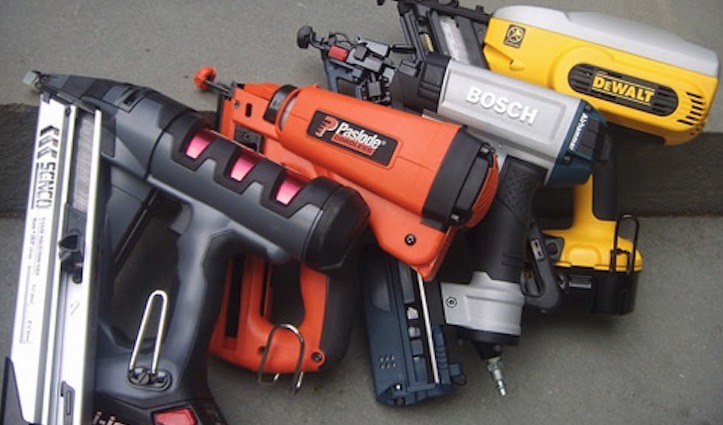Have you been eyeing your next home improvement? Or planning to do a DIY project at home? Buying a nail gun as your next handy tool would be worth your consideration.
In case you have never ever used a nail gun before, these power tools can make your DIY project way easier, not to mention safer. That’s why it’s essential to fully understand how the nail gun works and what are the different types of nail guns available on the market.
For starters, there’s a nail gun that works best for simple DIYs and home projects. This can be very handy for beginners and new nail gun users. On the other hand, there are also nail guns created for more hardcore construction purposes, which means they’re built perfect for both easy and intense projects that you might have. Besides that, there are other nail guns suited for different tasks, which we’ll talk about later on.
The Different Kinds of Nail Guns and their Uses
To start with, when looking for a nail gun, you must consider what powers it. For example, big props to technological advancements, battery nail guns are now more powerful with their new lithium-ion batteries and improved mechanization.
On the other hand, nail guns used for construction and other intense home projects use more power, which means they have an air compressor to fuel them as they tend to be more demanding than typical battery-designed nail guns.
Additionally, there are also nail guns that use replaceable fuel cells like the Paslode. This kind of nail gun is best for people who need a cordless type of framing nailer. Other brands that manufacture battery-powered nailers include Dewalt and Craftsman.
Firing Methods
If you have no idea about nailers, always remember that there are two different firing methods: sequential firing, and dual-contact firing or bump firing. These two differ in terms of their mechanisms and how they are done.
For sequential firing, you can fire the nail gun by pressing the nosing onto the work piece. Afterward, fire the nail by pulling the trigger. And although this is the safest and most recommended, always be sure to keep your face at a safe distance from the nailed piece. On another note, bump firing or dual-contact firing happens once you pull the trigger and then pressing the nail gun nosing onto its workpiece. Once you pull the trigger, it will automatically fire the nail onto the object.
In terms of safety, professionals always recommend sequential firing as it is safer and more accessible. In contrast, dual-contact firing helps quickly place several nails into the project but much more dangerous, especially for newbies and new nail gun users.
Now that you already know how to fire a nail gun, we’ll dig deeper into the other kinds of nailers.
Here’s all the Types of Nail Guns on the Market:
Framing Nailers

For major wood projects such as conventional housing and deck construction, a framing nail gun is commonly used. It utilizes nails, usually around 21⁄2″ to 31⁄2″ in length, and can have either a round or clipped head.
These are usually extremely powerful nail guns, which are perfect for industrial applications. The framing nailer would be perfect for you if you are going to work with high-strength wood and planning to build housing frames.
Roofing Nailers
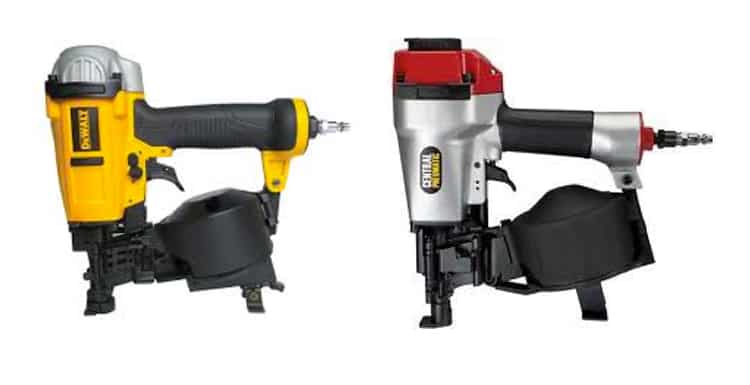
When your next project involves nailing new roofs, using roofing nailers would be the best tool for you as this tool usually consists of nailing down shingles of asphalt. With this tool, the depth of the nail shots into the shingle can be controlled, which is also known as the adjustment of the depth drive.
This is important since these shingles are usually somewhat fragile and normally there would be too much force going through the shingle once fired. That’s why this gun always has nails that are of a broad flat head itself. And instead of a straight clip, these nail guns normally come with a coil that enables you to carry more nails at once.
Finishing Nailers
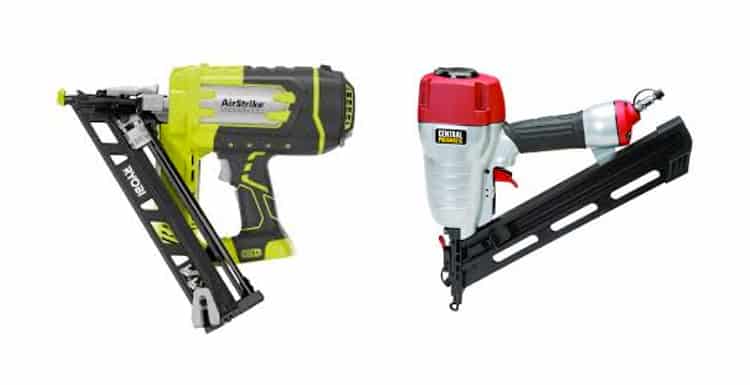
With the finishing nailers, you can do tons of things that are fairly diverse. They can be used for trimming, molding, door jams, cabinets, and even many minor woodworking applications. And the best part? You can produce prime cabinets with this tool.
What makes a fantastic nailer for finishing? Check out the nail types used:
Gauge: 14-16
Nails: 1′′ to 2 1⁄2″
These nails are far smaller than what a framing nailer can use, yet a bit beefier than the brad nailer. This tool also offers the nail a bit more grip for anyone who does thick crown molding.
Additionally, cordless tools have become increasingly accessible in finishing nailers. Lithium-ion finishing nails are popular through improvements in technology and increased demand. This is fantastic because you don’t need a nailer but a few minutes or seconds out of the day, if you’re a regular DIYer. You won’t need a lot of required time for setting up an air compressor and a pump so it’s a wonderful time-saving tool since all you need to do is snap on a battery and use it immediately.
If you’re a beginner woodworker, a finishing nailer might not a bad choice; however, many would recommend a brad nailer because of its ease of use.
Brad Nailers
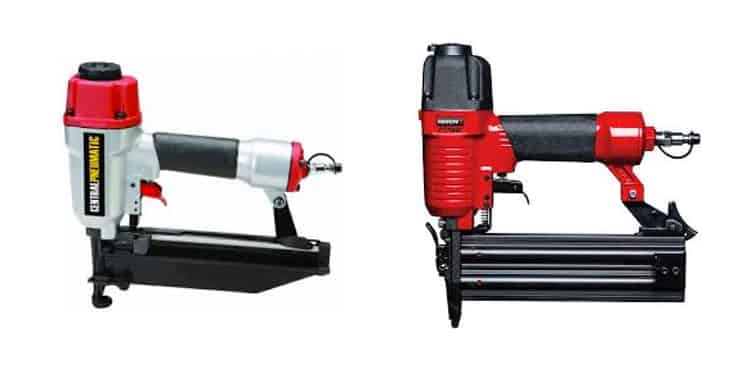
In my opinion, the brad nailer is DIYer’s most versatile nailer. It can manage many woodworking projects like trims and repairs in the average household. The nails are also sufficiently strong and have good gripping power.
Also, they differ in a few different ways from the finishing nailer. Firstly, the nail rail is not angled as the finishing nailer.
The other nails are:
1⁄2″ – 2′′ nail lengths
18 gauge nails
Moreover, these nailers are provided in both cordless and regular air connections much like with the finishing nailers.
Pin Nailers
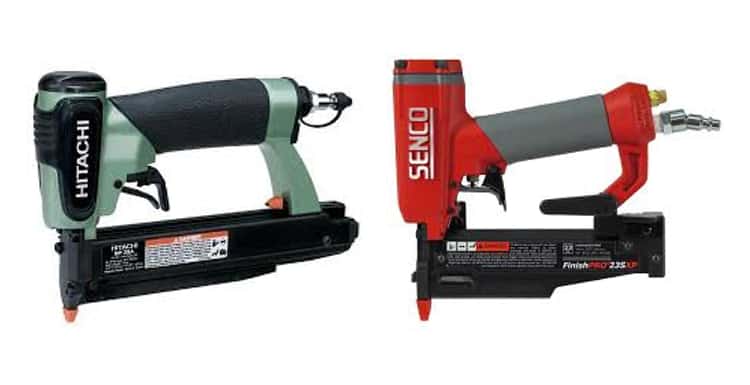
For those looking for smaller woodwork and upholstery nail guns, a pin nailer is perfect for you. With this tiny staple gun, it is a step up from the other tools on our list.
Even if the size and power are little, this nail gun will become quite handy if you undertake a lot of DIY projects.
They are made from 22 or 23 nails and these are with or without a head. This kind of nail is also ideal for light woodwork, like a birdhouse or a little crate with panels.
In the end, it’s still an amazing nailer in the repertory of your tools.
Conclusion
In the end, nailers can make your life much easier, especially if you want to try to do your work around the house quicker and simpler.
If you are a beginner, it’s best to start with the brad nailer for your projects. Experts advise that you purchase this one before the others on this list. Moreover, if you want to make any substantial roofing or framing of a house, then the roofing or framing nailers are perfect for your toolset. If needed, add the brad nailer to your set.
However, you can buy the finish and pin nailers when you really have a need them or if you simply just want to own these. Of course, these nailers aren’t really needed much when doing simple DIYs at home so it wouldn’t be advisable if you buy them when you would probably never use them.
Additionally, with today’s modern technology, it’s a no-brainer if you’ll want to acquire a battery-powered nailer knowing the progress in cable-less battery technology. And it’s only best to have an air nail gun if you have the infrastructure to use the air nailer with. Plus, you don’t have to look into how to use the hose connected to the tool, since with the battery nailer, it is so much easier to use.
As with any other power tool, it would be wise to apply safety procedures and security protocols to any of those instruments. Always remember to use eye and hearing protection.
